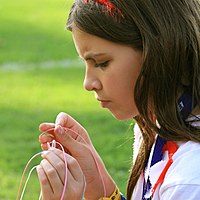
Photo from wikipedia
OBJECTIVES Bipolar II depression (BD-II) is a subtype of bipolar disorder with recurrent depressive, manic, and frequent depressive episodes as the main clinical manifestations. This study aimed to compare the… Click to show full abstract
OBJECTIVES Bipolar II depression (BD-II) is a subtype of bipolar disorder with recurrent depressive, manic, and frequent depressive episodes as the main clinical manifestations. This study aimed to compare the cognitive function of patients with BD-II with those of healthy siblings and controls to explore the internal phenotype of BD-II in the field of cognitive function. METHODS 66 BD-II patients, 58 healthy siblings, and 55 healthy controls were assessed with the Trail Making Test (TMT), Digit Symbol Coding Test (DSCT), Category Fluency, Hopkins Verbal Learning Test-Revised (HVLTR), Brief Visuospatial Memory Test-Revised (BVMT-R), Wechsler Memory Scale 3rd ed. Spatial Span Subtest (WMS-III SS), Neuropsychological Assessment Battery Mazes (NABM), Continuous Performance Test, and Identical Pairs (CPT-IP). RESULTS Patients with BD-II showed cognitive deficits in visual learning, reasoning and problem solving, verbal learning, attention/vigilance, working memory, and speed of processing. Healthy siblings showed cognitive deficits in reasoning and problem solving, verbal learning, attention/vigilance, working memory, and speed of processing. Substantial differences were observed among the three groups in reasoning and problem solving. CONCLUSIONS Verbal learning, working memory, and attention/vigilance may be potential endophenotypes that can be used to identify BD-II among Han Chinese in the early stage.
Journal Title: Acta psychologica
Year Published: 2022
Link to full text (if available)
Share on Social Media: Sign Up to like & get
recommendations!